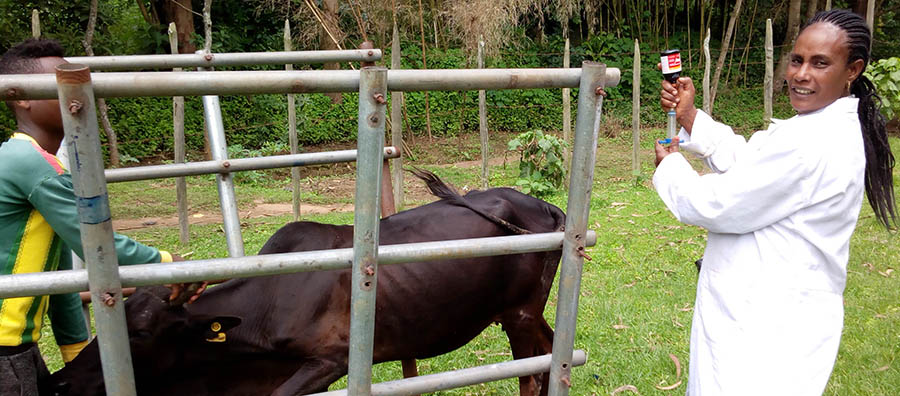Yederawork Defar makes her way through the gap in the wooden fence, and comes face to face with her next target. It sounds like it could be sinister but it is far from it.
Yederawork’s “targets” are the goats, cattle and other livestock that reside on this smallholder farm in the Malga district of southern Ethiopia’s SNNR Province. They are about to be administered an albendazole injection, a medication to treat them for, and immunise them from, various pests to which livestock in Ethiopia are commonly a host.
Yederawork’s job as an animal health assistant is to keep farm livestock healthy, productive and free from pests. And in rural, remote Ethiopia, keeping farm animals healthy and alive is vital – because of the nation’s overall reliance on agriculture.
Indeed, livestock is critical to this sector, as live animals and their products account for 40 per cent of the agricultural economy, in the country that has the largest livestock population in Africa. Current estimates put the number of cattle in Ethiopia at over 43 million, sheep at 24 million, goats at 19 million and donkeys at 4.5million.
The fortunes of a high proportion of the Ethiopian economy effectively starts and ends, rises and falls, in line with the health of the agricultural sector. More than 70 per cent of low income families here are employed through agriculture, and it contributes up to 60 per cent of the gross domestic product (GDP) of the nation.
The Ethiopian Government knows this, and more than six years ago created the Agricultural Transformation Agency (ATA) as a catalyst to modernize and drive positive, transformational, and sustainable change of the sector.
For more than three decades, Self Help Africa has been working to improve agricultural productivity and performance to reduce poverty and increase food security in Ethiopia.
In my role with Self Help Africa, I am Team Leader for a five-year Livestock Market Development (LMD) project, backed by the US Government’s Feed the Future initiative as part of its commitment to Ethiopia’s agricultural growth. This scheme recognises the importance of livestock to the growth of agriculture, and the protection of animals against pests and disease is a critical part of its work.
We’re implementing the program together with quite a few partners and stakeholders, but we’re all pulling in the same direction – ending poverty, and enhancing growth and incomes in Ethiopia.
Recently, I joined Yederawork as she visited smallholder farmers in Manicho village, about an hour’s drive from Hawassa, the regional capital on the shores of Lake Awasa in Ethiopia’s Great Rift Valley. Manicho is one of seven villages covered by Yederawork in the local district.

A 38-year-old widow and mother-of-three who comes from the local area, Yederawork is one of more than 300 animal health assistants involved with the project – and importantly, she’s one of 80 women who fill the role of frontline veterinary health workers.
Gender is important here – a strong representation of women on our team is helping to address a long-standing challenge facing Ethiopia’s farming sector – the diminished role that women have traditionally played on farms.
Yederawork says that no farmers she works with have an issue dealing with a woman animal health assistant. Rather, they are grateful for the visit and the attention given to their livestock – it makes no difference to them whether their animals are being seen by a man or a woman.
Yederawork, who visits between 150-200 households every month, says she enjoys a positive relationship with the farm families with whom she works. “Farmers have a positive attitude towards me. They respect me and give me their support, and some even say that they are grateful, because I show up on their farms at the time that I say that I will!” she said.
Treating ruminant pests is part of her everyday routine, with both endo and exo parasites, particularly tick and flea infestations, the most common problems.
Yederawork provides ivermectine injections for external parasites, or the aforementioned albendazole for internal ones. Sometimes, if the necessary equipment is available, extopore spray on barns will also be used in an attempt to eradicate external parasites.
The work she is doing is vital, as farmers in her locality have traditionally had little access to veterinary support at local level, and as a result, tick and pest-borne viruses and viral diseases have had a devastating impact on domestic livestock.
The level of care she and her colleagues can provide at village level has improved as a result of additional technical training they have received through the programme. They have also strengthened their skills, and can more easily identify diseases and diagnose appropriate treatments in a timely fashion.
“Through the programme, I also got the opportunity to visit and gain experience with private drug stores and veterinary clinics in the town, where I learned about vet equipment and treatments that I wasn’t aware of before. This has helped me in my role,” Yederawork said.
As I joined Yederawork on her rounds, we agreed that part of the effectiveness of the programme was down to how it provided farmers with training so that they too can play a role in intervening and treating their animals for pests.
“There are biological resources available locally that can help, and indigenous pesticides that can help,” she said. “They are inexpensive and, while sometimes not as effective as conventional pharmaceuticals, they can help support farmers to tackle a problem in the first instance.”
It is this approach – incorporating both farmer and animal health professionals – that has Yederawork and I confident that the programme will continue to improve and maintain the long-term health of Ethiopia’s rural livestock population in the years ahead.
This article originally appeared in WFO’s Farmletter.



